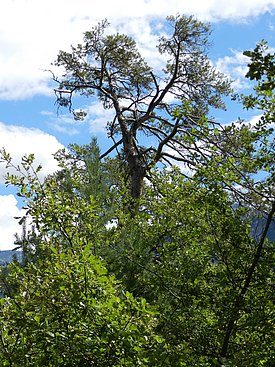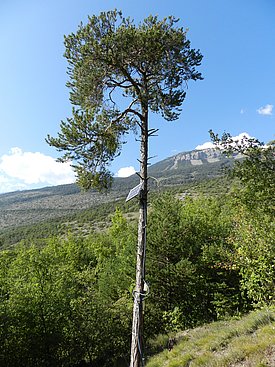Understory removal experiment Salgesch
2010 - 2025
CoopérationIn the low elevation forests within alpine central valleys, such as the Valais, pines have shown unprecedented signs of decline since the end of 20th century, mostly attributed to repeated droughts. However, these forests have also experienced drastic changes in land use, which specific effects and interactions with the climatic drivers are still unclear. Since 2010, the Salgesch understory removal experiment has been completing investigations performed at the nearby Pfynwald research site, focusing on the consequences of recent understory development on the ecosystem processes and dominant pine growth and ecophysiology.
Located on the South-oriented lower slopes nearly opposite to Pfynwald, Valais, the Salgesch research site shows average yearly temperature of 11.7 °C and annual precipitation amounting to 620 mm (2010-2014 averages from local Agrometeo station at 627 m a.s.l.). The stands include dominant 120- to160-year-old trees and dense mixed understory. Prior to abandonment in the 1960s, traditional forest use included sheep grazing and forest litter harvesting. In 2010, a WSL research team started an experiment complementary to the ongoing long-term irrigation experiment at Pfynwald, to specifically address change in land use issues and their effects on the dominant pines. This assay has developed into a long-term experiment to investigate responses in the different ecosystem compartments.
The actual experimental design consists of six circular plots, 5 m in diameter and centred on one dominant Pinus sylvestris tree, with the woody understory vegetation removed at the start of experiment and resprouting being eliminated systematically. Six other plots are left as control. The climate is being monitored by means of nearby meteorological stations of Agroscope, soil sensors are measuring temperature and water content at three depths (online data access) and other sensors are monitoring the tree growth and stem ecophysiology of dominant pines. Responses in the tree crown, soil compartment and herbaceosus vegetation are assessed during repeated measurement campaigns.
The results to date show trends partially paralleling those observed at the irrigation experiment Pfynwald. The treatment has caused a steady increase of soil moisture and temperature up to 16 % (60 cm) and 19 % (5 cm). The trees in thinned stands have immediately responded to treatment with larger stem flows and stem/foliage growth (Giuggiola et al. 2018). However, this initial release effect has been then fading, despite unchanged soil moisture availability. Regarding the soil moisture supply of dominant pines, the current results thus suggest a superior limitation by climate rather than understory competition, because of the dry climate and small soil water reservoir.
Links ¶
Publikationen ¶
Giuggiola, A., Zweifel, R., Feichtinger, L. M., Vollenweider, P., Bugmann, H., Haeni, M., & Rigling, A. (2018). Competition for water in a xeric forest ecosystem – Effects of understory removal on soil micro-climate, growth and physiology of dominant Scots pine trees. Forest Ecology and Management, 409, 241-249. https://doi.org/10.1016/j.foreco.2017.11.002
Haeni, M., Hiltebrand, F., Giuggiola, A., Rigling, A., & Vollenweider, P. (2017). Understory removal of a Scots pine forest near Salgesch: Soil volumetric water content and temperature time series, hourly time resolution, 2010-2016. Swiss Federal Institute for Forest, Snow and Landscape Research, PANGAEA. https://doi.org/10.1594/PANGAEA.867266


